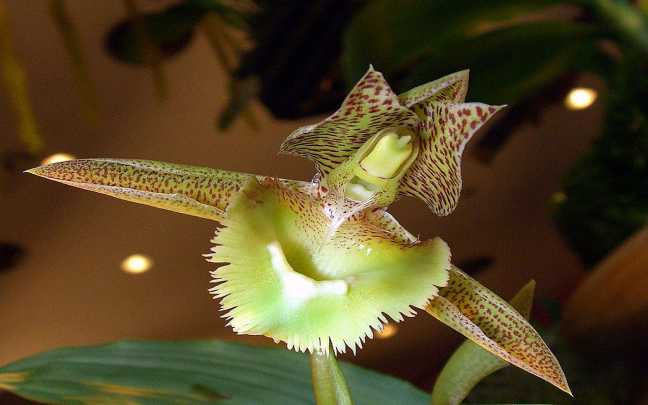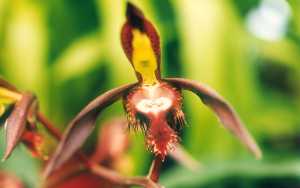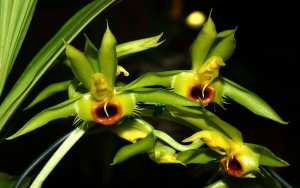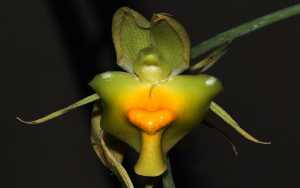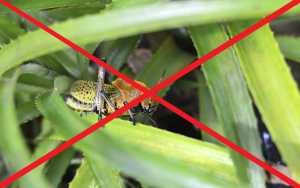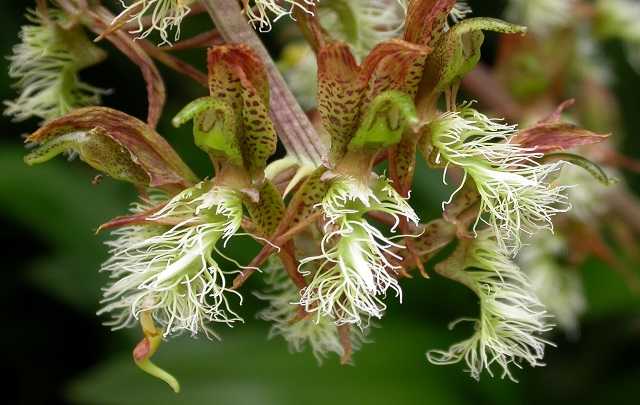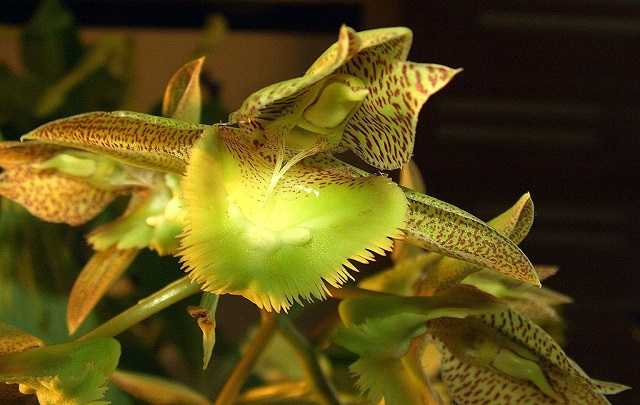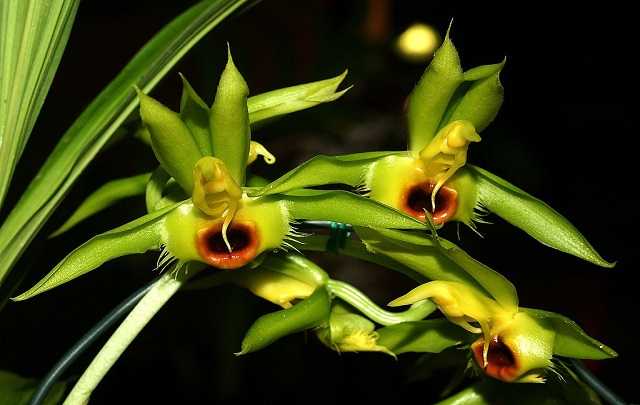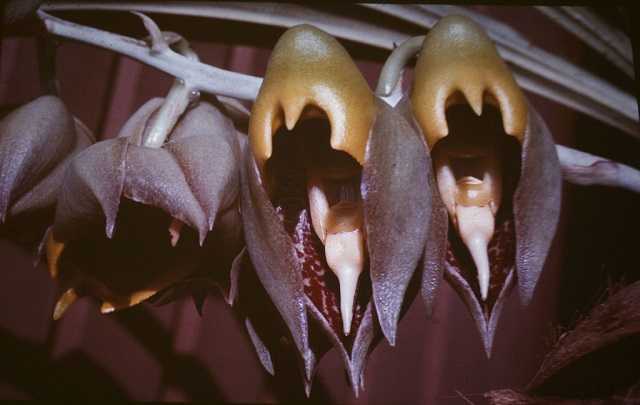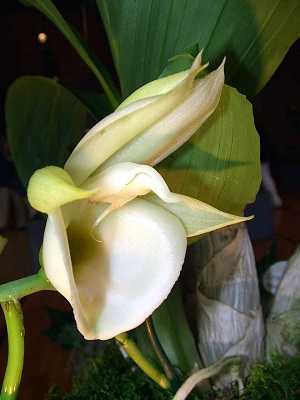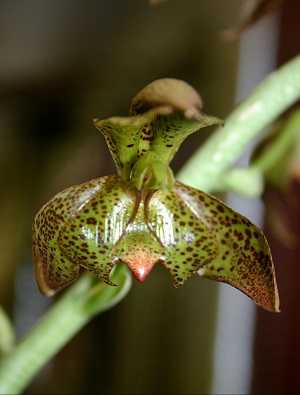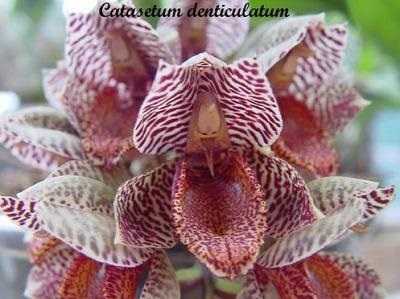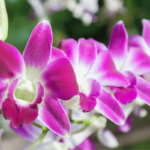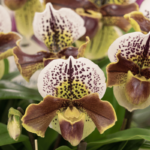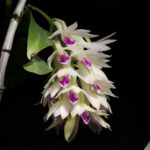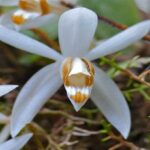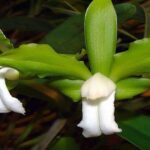The genus Catasetum orchids comprises about 176 species.
Most of them are epiphytic orchids, with some being terrestrial or lithophytic.
They are mainly found in the American continent, from Mexico through Central America to northern Argentina. The Amazon Rainforest stands out due to its abundance of species.
A very curious characteristic of this genus is that it has the ability to have flowers of both sexes, and they are rarely hermaphroditic.
How to Care for Catasetum Orchids
To cultivate Catasetum orchids, you should follow these guidelines:
- Warmer temperatures
- Low humidity (dry climate)
- Plenty of indirect light
- Proper watering at each stage
- Fertilize with NPK 30 10 10 or NPK 10 30 20
- Gentle breeze
Below, you will learn more in-depth about each of these factors, but know that Catasetums, in general, are straightforward plants to cultivate.
They are very interesting orchids to have, but for them to be healthy, you need to take some precautions.
And it is about these precautions that we will talk below. If you follow them, you can be sure that your orchid will have excellent blooms.
1 – Temperature
The ideal temperature helps your orchid resist pests and diseases and can also stimulate flowering.
In the case of Catasetum, it prefers warmer environments, and its growth period is during summer.
During this time, the ideal temperature during the day is 25ºC to 38ºC (77°F to 100.5°F), with some variation allowed.
At night, it should be 16ºC to 18ºC (61°F to 64.5°F), with some variation allowed.
After this period, the pseudobulbs will have matured, so the ideal temperature will be:
- 21ºC to 29ºC (70°F to 84°F) during the day
- 13ºC (55.5°F) at night, with some variation allowed.
2 – Humidity
Humidity is a very important factor, and if it is excessive or lacking, your Catasetum orchid can be greatly affected by diseases.
There are several diseases caused by excessive humidity, such as black rot.
Moreover, humidity directly influences other essential factors for your orchid’s cultivation, which are:
- Temperature (With high humidity, the orchid can withstand more heat)
- Watering (The higher the humidity, the less we should water)
For Catasetum orchids, the ideal humidity is 40% to 60%, usually in a slightly drier climate.
3 – Lighting
Like Brassavola and many other orchids, Catasetum prefers to be in places with indirect sunlight.
To check if your orchid is receiving the right amount of light, do the following check:
- Is the leaf darker green than normal? If yes, it needs more light.
- Is the leaf more yellowish than normal? If yes, it needs less light.
A tip, Catasetums really like brightness.
4 – Watering
We’ve come to one of the most interesting factors of Catasetum orchids.
This is because the way to water them is a bit different from most orchids.
Like dendrobium orchids and all other orchids, Catasetums have a life cycle that repeats several times.
- Growth
- Flowering
- Dormancy
Basically, Catasetum needs to store water for its dormancy period because it doesn’t like to be watered during this time.
So during the growth period, they store a large amount of water.
What you should do is water a lot during the leaf growth period of your orchid.
When the pseudobulbs are mature, gradually reduce the frequency of watering.
Then, after flowering, the leaves will start to dry and turn yellow, so the Catasetum will lose all its leaves, and at this point, the dormancy period will begin.
During this period, you can only water your orchid if the pseudobulb is very dry.
Some tips for the growth and flowering period:
- Watering should only be done in the morning.
- Avoid watering on days with high humidity.
5 – Fertilization
If you want to learn how to care for Catasetum, correct fertilization will:
- Make your orchid stronger against diseases
- Produce more and beautiful flowers.
When Catasetum is in the growth period, use NPK 30 10 10.
And after the pseudobulbs have formed, use NPK 10 30 20; this way, you will stimulate flowering.
6 – Ventilation
This can be considered one of the most important factors in preventing pests on your Catasetum orchids.
Basically, ventilation in your plant should be a breeze, if possible not too humid.
The wind with the ideal humidity can help your orchid bloom.
But moist wind, especially when combined with low temperatures, can reduce your orchid’s resistance.
I recommend that you place it in an open environment where ventilation occurs normally.
And be careful on very windy days, especially rainy days.
7 – How to Avoid Pests
If you have followed all the tips in this article, your catasetum orchid will be healthy and unlikely to have diseases.
But pests can still attack it, especially aphids, mealybugs, and mites.
To learn how to combat them, see this article.
And a very important tip, the best way to avoid pests is always by observing your orchids.
For more tips on how to avoid pests and diseases, see this article.
8 – How to Plant
To plant the catasetum orchid, follow the steps below:
- Choose your pot (I recommend plastic or terracotta)
- Put some gravel at the bottom for drainage
- Add the chosen soil
- Fit the seedling in the center of the pot
- Add more soil to secure the seedling
- Use a barbecue stick for staking.
Catasetums can be planted all year round.
It is recommended to plant them when they start sprouting and generating new roots.
The big difference in planting this species is that as it sprouts on both sides, you should place it in the center of the pot when planting.
The ideal pot is plastic when in drier places and clay for places with higher humidity.
Remember that the pot should leave the orchid with its roots tight, with very little space.
Do not let the roots be free, as this will hinder growth and the health of your orchid.
If you want to learn more, watch this video:
Catasetum Species
As already mentioned, there are about 176 species of catasetum, and practically all of these species are found in South America.
Below are some of the main species of catasetum:
- Catasetum albovirens
- Catasetum ariquemense
- Catasetum atratum
- Catasetum barbatum
- Catasetum cassideum
- Catasetum cernuum
- Catasetum denticulatum
- Catasetum fimbriatum
- Catasetum fuchsii
- Catasetum galeritum
- Catasetum gladiatorium
- Catasetum gnomus
- Catasetum juruenense
- Catasetum macrocarpum
- Catasetum macroglossum
- Catasetum mattosianum
- Catasetum osculatum
- Catasetum pileatum
- Catasetum planiceps
- Catasetum purum
- Catasetum saccatum
- Catasetum sanguineum
- Catasetum semicirculatum
- Catasetum socco
- Catasetum spitzii
- Catasetum trulla
- Catasetum uncatum
- Catasetum vinaceum
Some of these plants stand out for their beauty, others because they are easily found for purchase.
See below a little more about some of these species:
Catasetum barbatum
Catasetum barbatum is an epiphytic plant, and in some cases terrestrial.
It is native to South America, and can be found in Brazil and also in Venezuela.
In Brazil, it is commonly found in the states:
- Amazonas
- Minas Gerais
- Mato Grosso
- Goiás
During its flowering, it usually gives us 12 usually male flowers.
Female flowers in this species are usually much smaller than male ones.
It is an orchid that likes a lot of air and a lot of indirect light, and as for its substrate, it should be the one used in epiphytic orchids.
Catasetum fimbriatum
Catasetum fimbriatum is probably the most famous orchid of the catasetum genus.
This is an orchid found in several other locations in South America.
It is found mainly in:
- São Paulo
- Minas Gerais
- Mato Grosso
- Mato Grosso do Sul
- Goiás
- Pará
- Paraná
- Among several other states
You can usually find it in forests at an altitude ranging from sea level to 500 meters (1640,4 feet).
Its leaves are very large and thin.
Its flowers appear on stems that range from 25 to 45 centimeters (9.8 to 17.7 inch) and can appear in 7 to 20 copies.
It is possible to find yellow flowers with red parts and in some cases green flowers.
To cultivate Catasetum fimbriatum, follow the tips below:
- Provide good aeration for the roots.
- Do not let water accumulate at the bottom of the pot, as this can cause serious diseases.
- In the dormant period of this plant, avoid getting it wet as much as possible.
- It is very resistant to high and low temperatures, but do not overdo it.
- Medium lighting, about 50% shading.
Catasetum osculatum
Catasetum osculatum is an epiphytic orchid that appears mainly in the state of Mato Grosso.
Its flowering occurs in summer, and in some cases it can bloom up to 3 times a year.
Each flowering has an average of 15 flowers, each one up to 5 cm (2 inch).
These flowers can be mainly two colors, green and wine.
Those of wine color belong to the variety Catasetum osculatum var. wine.
This is an orchid that likes to be watered a lot, but you must be very careful not to accumulate water in its roots, as it is very susceptible to black rot disease.
Catasetum macrocarpum
Catasetum macrocarpum is a bit easier orchid to find.
It is native to South America, especially the following countries:
- French Guiana
- Brazil
- Argentina
- Venezuela
- Colombia
- Among others
This is an epiphytic orchid that can be found at altitudes from sea level to 1300 meters (4265 feet).
A great characteristic of this plant is that its flowers give off a very strong and pleasant smell.
Its flowers appear in late summer and gradually open, but they do not fully open.
They last about 7 days and are quite thick.
Catasetum pileatum
Catasetum pileatum is an epiphytic plant found in South America.
It was described in 1882 by Heinrich Gustav Reichenbach in the journal Gardeners’ Chronicle.
It is found in the following countries:
- Brazil
- Venezuela
- Ecuador
- Colombia
- Trinidad and Tobago
The first discoveries of this species occurred in Venezuela.
They were discovered and sent to England.
Regarding its flowers, like the vast majority of catasetums, they can be of both genders.
Differentiation is very simple in this case.
Male flowers are larger, appear in greater numbers, are fleshier, and last longer.
This is an orchid that likes moderate temperatures, ranging from 15ºC to 30ºC (59°F to 86°F).
A curiosity is that it was the national flower of Venezuela until 1951.
But it was replaced by Cattleya mossiae var. wagnerii.
Catasetum cernuum
Catasetum cernuum is a very small orchid, usually about 10cm (4 inch) in size.
It is considered an easy-to-cultivate plant and can be easily found for purchase.
This is an epiphytic plant, found in several countries in South America, especially:
- Brazil
- Venezuela
- Trinidad and Tobago
It was described by biologist John Lindley and is found between 200 and 1500 meters (656 and 4921 feet) above sea level.
To cultivate Catasetum cernuum, you should provide a warmer climate with moderate shade and colder nights during the winter.
It has 6 to 8 leaves and loses all of them in winter.
Its flowering occurs in autumn and produces between 10 and 15 flowers that range from 3 to 4 centimeters (1.18 to 1.57 inch) wide.
Catasetum denticulatum
Catasetum denticulatum was described by Francisco Elde Miranda in 1986. It is found in the state of Rondônia and also in the Amazon. They typically live at altitudes ranging from 100 to 300 meters (328 to 984 feet) and are epiphytic.
Their flowering occurs between spring and summer.
They can produce up to 15 flowers, each about 4 centimeters (1,57 inch) long on average.
These flowers are usually white and pink with spots of various colors such as brown or wine.
To cultivate them, you should provide moderate lighting and rest during the dormancy months.
In other words, during the dormancy period, reduce watering and fertilization.
Additionally, good ventilation and watering without wetting the leaves are essential.
7 Curiosities About Catasetum Orchids
Now that you’ve learned how to cultivate the Catasetum orchid and discovered its main species, here are some interesting facts about this plant:
- Many Catasetum species live in warm locations, so a higher temperature is usually recommended for them.
- As mentioned earlier, they have flowers of both sexes and hermaphrodites (less frequently).
- They can produce dozens of flowers, and in some species, these flowers are fragrant.
- After flowering, the pseudobulb becomes spiny.
- It hasn’t been proven yet, but many believe that to generate male flowers, you just need to place your Catasetums in a shaded area.
- Many orchid enthusiasts abbreviate the name Catasetum to cstm.
- The orchid fredclarkeara after dark is a hybrid of this genus and is also known as “black Catasetum.”
Conclusion – Catasetum Orchids
This was the complete guide on how to care for Catasetum orchids.
If you have any questions about what was discussed in this article, leave a comment, and we’ll try to respond as quickly as possible.
If you liked this article, help us spread the word to more people.
Click the buttons below and share this content with your friends.

